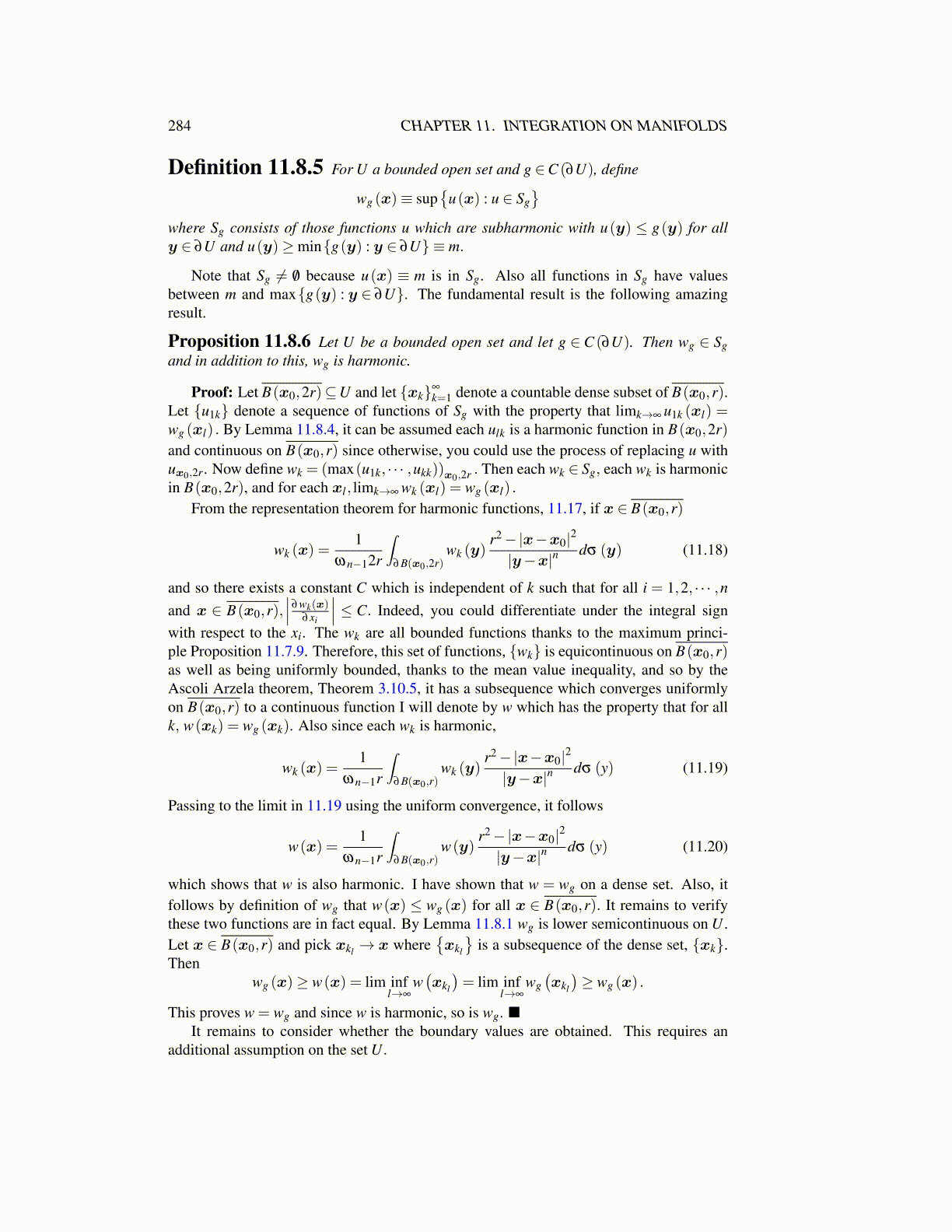
284 CHAPTER 11. INTEGRATION ON MANIFOLDS
Definition 11.8.5 For U a bounded open set and g ∈C (∂U), define
wg (x)≡ sup{
u(x) : u ∈ Sg}
where Sg consists of those functions u which are subharmonic with u(y) ≤ g(y) for ally ∈ ∂U and u(y)≥min{g(y) : y ∈ ∂U} ≡ m.
Note that Sg ̸= /0 because u(x) ≡ m is in Sg. Also all functions in Sg have valuesbetween m and max{g(y) : y ∈ ∂U}. The fundamental result is the following amazingresult.
Proposition 11.8.6 Let U be a bounded open set and let g ∈ C (∂U). Then wg ∈ Sgand in addition to this, wg is harmonic.
Proof: Let B(x0,2r)⊆U and let {xk}∞
k=1 denote a countable dense subset of B(x0,r).Let {u1k} denote a sequence of functions of Sg with the property that limk→∞ u1k (xl) =wg (xl) . By Lemma 11.8.4, it can be assumed each ulk is a harmonic function in B(x0,2r)and continuous on B(x0,r) since otherwise, you could use the process of replacing u withux0,2r. Now define wk = (max(u1k, · · · ,ukk))x0,2r . Then each wk ∈ Sg, each wk is harmonicin B(x0,2r), and for each xl , limk→∞ wk (xl) = wg (xl) .
From the representation theorem for harmonic functions, 11.17, if x ∈ B(x0,r)
wk (x) =1
ωn−12r
∫∂B(x0,2r)
wk (y)r2−|x−x0|2
|y−x|ndσ (y) (11.18)
and so there exists a constant C which is independent of k such that for all i = 1,2, · · · ,nand x ∈ B(x0,r),
∣∣∣ ∂wk(x)∂xi
∣∣∣ ≤ C. Indeed, you could differentiate under the integral signwith respect to the xi. The wk are all bounded functions thanks to the maximum princi-ple Proposition 11.7.9. Therefore, this set of functions, {wk} is equicontinuous on B(x0,r)as well as being uniformly bounded, thanks to the mean value inequality, and so by theAscoli Arzela theorem, Theorem 3.10.5, it has a subsequence which converges uniformlyon B(x0,r) to a continuous function I will denote by w which has the property that for allk, w(xk) = wg (xk). Also since each wk is harmonic,
wk (x) =1
ωn−1r
∫∂B(x0,r)
wk (y)r2−|x−x0|2
|y−x|ndσ (y) (11.19)
Passing to the limit in 11.19 using the uniform convergence, it follows
w(x) =1
ωn−1r
∫∂B(x0,r)
w(y)r2−|x−x0|2
|y−x|ndσ (y) (11.20)
which shows that w is also harmonic. I have shown that w = wg on a dense set. Also, itfollows by definition of wg that w(x) ≤ wg (x) for all x ∈ B(x0,r). It remains to verifythese two functions are in fact equal. By Lemma 11.8.1 wg is lower semicontinuous on U .Let x ∈ B(x0,r) and pick xkl → x where
{xkl
}is a subsequence of the dense set, {xk}.
Thenwg (x)≥ w(x) = lim inf
l→∞w(xkl
)= lim inf
l→∞wg(xkl
)≥ wg (x) .
This proves w = wg and since w is harmonic, so is wg. ■It remains to consider whether the boundary values are obtained. This requires an
additional assumption on the set U.